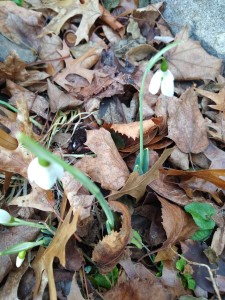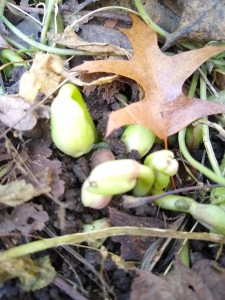 I have always envied gardeners who boast that they have something in bloom outdoors 365 days a year. In a cold winter climate that is just about impossible, unless you count the final fall flower remnants that somehow cling to blackened stems into January. I call that cheating and I won’t do it. At least not yet.
I have always envied gardeners who boast that they have something in bloom outdoors 365 days a year. In a cold winter climate that is just about impossible, unless you count the final fall flower remnants that somehow cling to blackened stems into January. I call that cheating and I won’t do it. At least not yet.
Maybe I won’t have to. On the day of the Winter Solstice—December 21—I discovered six snowdrops blooming in my garden. This has never happened before and may never happen again. I did nothing to encourage this miracle of nature other than planting the bulbs, but I am taking an unholy amount of pride in the accomplishment.
I was so excited about this Solstice event that I had half a mind to emulate the Druids and celebrate by lighting a Yule log while making an offering of mistletoe. Unfortunately the fireplaces in my house were long ago converted to coal and the garden center was already out of mistletoe. I had to make do with gazing fondly at the artificial mistletoe hanging on one of the Christmas decorations.
The plant tag that I stuck in the ground next to the early-blooming snowdrops seems to have disappeared, so I have only a vague memory of the species and variety. E-mail records were no help, since I ordered the bulbs by snail mail from my old friend, Hitch Lyman, who does not take electronic orders. I was exceptionally busy when the package arrived, and I neglected to jot down the names of the snowdrops I planted. Next year I will do better, but for now, feeble memory and educated guessing will have to suffice.
In the classic garden book, My Garden in Autumn in Winter, English gentleman gardener E.A. Bowles writes, “Snowdrops again should provide a flower or two from the appearance of Galanthus olgae in October until the forms of Galanthus nivalis come with a rush in February for Candlemas Day.”
Most likely my early risers are those mentioned by Bowles, a variety of what is now known as Galanthus reginae-olgae or Queen Olga’s snowdrop. If I recall correctly, I planted the Queen Olga bulbs last spring. Unlike many other early-flowering favorites, like crocus and daffodil, snowdrops are not planted in fall, but installed “in the green”, right after the flowers have faded and while the foliage is still viable.
The snowdrops are situated in what seems to be a desirable location—a small raised bed close to the house. The bed is sunny enough to support a rosebush, so the snowdrops get a good baking in the summer when they are asleep beneath the soil. This year they have been irrigated by record amounts of rain as well. Since it is the first year that I have grown snowdrops in that particular spot, there is no way of knowing whether location or genetics created the early flowering. It was probably a bit of both, but only time will tell.
The snowdrops’ appearance prompted me to walk around the garden and look for other signs of life. I investigated all the snowdrop spots. Since I have been collecting unusual species and varieties for many years now, those spots are numerous. Nary a snowdrop raised its head in any other garden location.
I inspected other plants. The flowering quince is not brave enough to think of budding right now. The only action in that quarter is emanating from the ghosts of last September’s sweet autumn clematis vines, which are still swaying from the naked quince branches. 
But in another raised bed, life flourished. The Christmas rose, or Helleborus niger, was not blooming yet and its base was camouflaged by a bed of dry leaves. Under those leaves, though, I found lots of fat flower buds clustered just above the soil surface. Depending on the progress of the current monsoon season and the amount of sunlight available, the hellebores should start blooming about a week from now. The Christmas rose has never flowered on Christmas for me, but at least this year there were well-developed buds on Solstice Day. I count that as horticultural victory.
Were my very early snowdrops yet another harbinger of climate change? Maybe. Certainly just about every other plant in the garden routinely sprouts, sets leaves and flowers earlier than it did when I was a novice gardener. On the other hand, I don’t believe that I have ever grown Galanthus reginae-olgae before. Maybe the Queen is just living up to her reputation as an early riser.
